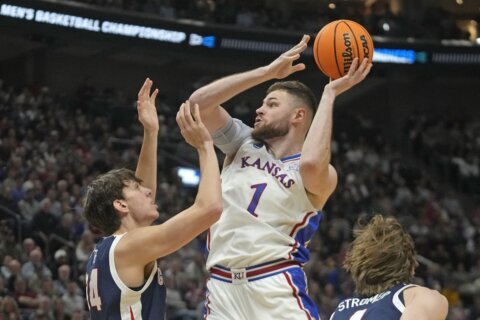(CNN) — Braelen Bridges had finally made it. In 2021, after establishing his college basketball career at two smaller schools, he was set to play his very first game for the University of Georgia – the big leagues to many kids who, like Bridges, grow up in the Atlanta area.
But before Bridges could set foot on the court, he had to undergo the extensive cardiac screening program the school required for every student-athlete. What it found had him in shock.
He had an enlarged aorta, a condition that can be deadly if not treated.
“It really made me think about, like, stopping playing … just questioning if I want to play again,” Bridges said.
Recent high-profile cases of cardiac arrests in otherwise healthy Black athletes like Damar Hamlin and Bronny James have put a focus on thorough cardiac screenings for athletes, something that many experts have been emphasizing for years, especially in players like Bridges who fall into the highest-risk category.
Young Black male basketball players in the NCAA’s Division I have a 1 in 2,000 chance of sudden cardiac arrest, according to a 2020 study co-authored by Dr. Jonathan Drezner, director of University of Washington Medicine’s Center for Sports Cardiology, published in the British Journal of Sports Medicine.
By comparison, their White counterparts have a 1 in 5,000 chance, according to the research.
It’s a statistic that Drezner thinks about a lot – it’s hard not to do so in the middle of March Madness – but what Drezner hopes is that all the players on the court have had extensive cardiac screening.
“There’s no excuse,” he said.
What screening looks like
Most athletes, even those in high school, will have a cardiac screening. It often involves collecting information about family history and conducting a basic physical exam.
The athlete might answer questions like, have you ever had tightness in your chest during exercise? Or, has any family member or relative died of heart problems?
The physical will measure things like blood pressure and pulse and listen for heart murmurs.
“Every athlete is undergoing cardiac screening. It’s just whether or not it’s done well. And so most kids just get this history and physical that basically doesn’t do much at all and has a very, very low chance of identifying the kid at risk,” Drezner said.
For one thing, athletes can have limited or misleading information about their family history, adds Dr. Fred Reifsteck, the UGA Athletic Department’s head team physician.
“Some people might say, ‘Well, I had a cousin who died in a car accident,’ or you know, some other accident, but it’s really cardiac-related.”
UGA’s cardiac screening program goes a step further. Since 1995, the university has included an electrocardiogram or ECG and an echocardiogram for all student-athletes as part of its pre-participation physical exam.
An ECG, sometimes called an EKG, looks at the heart’s electrical activity, and an echocardiogram looks at the blood flow through the heart and its valves.
Bridges had a family history of congenital heart conditions, and Dr. Jonathan Ho-Youn Kim, a sports cardiologist who consults for UGA Athletics, says that was the main driver for Bridges’ need for an echocardiogram, which was how he discovered the enlarged aorta.
“Having a family history of these kind of genetic heart conditions in younger people is definitely an indication to have a screening echo,” Kim said.
However, Kim – who is also the director of sports cardiology and an associate professor at Emory University – says he does not think echocardiograms are necessary across the board.
That’s because ECGs are an advanced screening tool and echocardiograms are a diagnostic tool, Drezner explains.
Not perfect
Kim also knows that no screening is perfect. “Whether you’re talking to athletes or cancer screening, you’re not going to catch everything.”
Take Bronny James, son of NBA superstar LeBron James and a combo guard at the University of Southern California. Several months before he went into cardiac arrest during a practice in July, a source familiar with the matter said, he had a cardiac screening that included an ECG and an echocardiogram.
A family statement later revealed that James had been diagnosed with a congenital heart defect. He was cleared for a full return to basketball in November and just declared for the 2024 NBA draft on Friday.
Even if these screenings can’t catch every problem, each additional athlete with a cardiac condition whom they can identify is a chance to help, said Drezner, who says an ECG screening in addition to family history and a physical is the best practice for cardiac screening.
“We can intervene in most of those cases and make them safer.”
For athletes who may not have any previous or immediate issues, these types of screenings can provide the school or team with a baseline, says Lance Schuemann, senior associate athletic trainer for UGA’s men’s basketball team.
This can help them determine the severity of any change or damage they might see during the season and help decide a course of action.
The point of these cardiac screenings is not to disqualify athletes. “This is an opportunity to put a young individual who might not have otherwise seen a doctor in front of a doctor,” Kim emphasized.
It’s also about their future health.
“We want to make sure it’s safe for you to play athletics at the University of Georgia. But looking forward for the rest of your life, we want to make sure that you might know about a condition that might affect you as you age,” Reifsteck said.
Why young Black male athletes?
There is no data that indicates a biological reason for why young Black male athletes have a higher incidence of sudden cardiac arrest and death, Kim and Drezner say.
It actually mirrors what happens in the general population, Kim points out.
One 2015 study found that 175 Black men per 100,000 in the US had an incident of sudden cardiac arrest, compared with 84 White men, from 2002 to 2012.
“These are inherited, structural heart conditions, structural arrhythmia syndromes. There is no data that has shown or suggests that Black individuals, young Black individuals, which include Black athletes, are more at risk for harboring these conditions,” Kim said. “Which, to me, makes sense, because race is a social construct.”
That’s why he thinks it’s more important to look at how the social determinants of health could be affecting this outcome.
This is also something Drezner has been studying. In a paper published this year in the British Journal of Sports Medicine, he and other researchers found that competitive Black male athletes who had sudden cardiac arrest were more likely to come from areas with higher Area Deprivation Index scores, which indicates greater socioeconomic deprivation, than White male athletes with the condition.
“The way I phrase it is that it’s not race – it’s perhaps racism – that has led to an increase in sudden cardiac arrest in Black athletes. And that’s a massive statement, but it’s really one that needs to be investigated, because it’s possible,” Drezner said.
Back in the game
“Ten years ago, it was ‘you have a cardiac condition.’ And it was very kind of line in the sand, and that line was very much on the conservative side. So it was what we call this paternalistic model,” Kim explained.
It meant a player like Bridges wouldn’t have been eligible to continue with the sport he loves.
Now, Kim says, there is a clearer picture of how much playing sports increases risk for people with certain heart conditions.
In his 20 years at UGA, Reifsteck says, he has had to medically disqualify someone based on a cardiac screening only once: because they had hypertrophic cardiomyopathy or HCM, a condition in which the heart muscle thickens and has a harder time pumping blood.
However, Kim says some new studies have shown that in people with HCM “who engage in a lot of vigorous exercise, that risk is no different in terms of kind of an adverse cardiac outcome compared to a patient with HCM who was not as vigorously active.”
But the decision to continue playing will always be on a case-by-case basis, says Kim, and is ultimately a shared decision between the doctors, athletes, their families and the school.
In Bridges’ case, an enlarged aorta wouldn’t typically lead to a cardiac arrest, but if it gets too large, it can tear and require immediate emergency surgery, Kim says.
To reduce this risk, Bridges started taking a beta blocker medication every day to help slow the dilation of his aorta. He has also paid closer attention to his diet to manage his blood pressure. And he was able to adjust his training at UGA by wearing a heart monitor and lifting lighter weights to reduce the stress on his heart. He will also continue to follow up with a cardiologist.
It was enough to help him decide to continue to play.
“I had just got to UGA. I feel like I just had worked to get it there,” he said. “Even though Dr. Kim said there’s always a risk, I felt like I had to just finish it out and continue to play. So it took just basically just believing in God and just taking the risk myself.”
Knowing that players like Bridges and Bronny James can continue to play with heart conditions or even after cardiac arrest is inspiring for Drezner, and they’re why he continues to advocate for early detection.
It’s also what has pushed Bridges to continue his career after UGA. He now plays professional basketball in Melbourne, Australia.
“It’s just a blessing that I met Dr. Kim, and he gave me the news that I needed and the confidence in order for me to continue to play, so I was just happy,” Bridges said.
But he also knows that one day, the risk could be too high.
“If [the aorta] continues to grow, I won’t be able to play sports anymore. So luckily, it hasn’t grown.”
Beyond Screening
As for whether extensive cardiac screening like ECGs should be performed on all athletes, Reifsteck says yes, but with some obvious caveats.
“There are an infinite set of problems to be solved by a finite set of resources,” he said.
Not every athlete can afford or will have access to an ECG, but there have been some visible efforts by teams like the Seattle Seahawks to provide more screenings for young athletes.
In addition to the cost of the tests, Kim also emphasizes that reading ECG and echocardiograms requires expertise, especially those for athletes.
Having the wrong person read them can lead to false positives.
“We also know that if somebody is reading the ECG who doesn’t know how to read an athletic ECG, calls it abnormal, then starts going down the rabbit hole of obtaining tests, which may lead to more tests, which may lead to more expenses. … Parents can’t afford these tests. Maybe they stopped playing sports, which is the worst thing that could happen if nothing was wrong with them in the first place,” Kim said.
Reifsteck advises parents to have a thorough knowledge of their family history to make basic cardiac screenings more effective.
“If you are the parent and you raise concerns about ‘oh, there’s this family history in our family,’ I think that puts your child on the radar screen for the provider. ‘OK, do we need to do more than just get a history and listen to their heart?’ ”
And if an athlete has a family history of heart conditions or has cardiac symptoms like chest pain or shortness of breath during exercise, Reifsteck says, he’d advocate for them to have a more extensive cardiac screening.
But beyond screenings, Reifsteck says, every team or school needs to have three essentials: automated external defibrillators or AEDs, people who know CPR and an emergency action plan.
These things helped save the life of Buffalo Bills safety Damar Hamlin after he went into cardiac arrest on live television last year. There was a clear plan in place that allowed him to receive medical attention quickly, which was crucial because each additional minute without CPR cuts the changes or survival after a cardiac arrest by up to 10%.
Hamlin has since been an advocate for having more CPR training and emergency action plans, something Kim says he doesn’t get enough credit for, considering the impact it can have.
It’s also why Kim is backing a bill in Georgia that would require all K-12 schools to have AEDs and emergency action plan practice drills.
“The most heartbreaking thing that can happen is when you hear a story of a young individual, whether an athlete or not at school, who had [sudden cardiac arrest] and die, and there was an AED nearby, but nobody knew where or that it existed,” Kim said.
The-CNN-Wire
™ & © 2024 Cable News Network, Inc., a Warner Bros. Discovery Company. All rights reserved.






